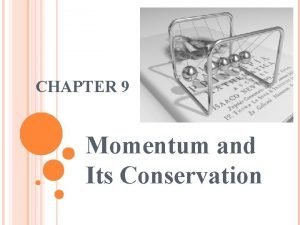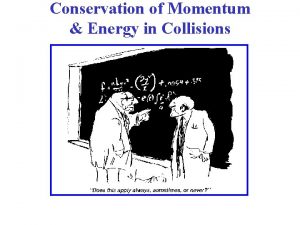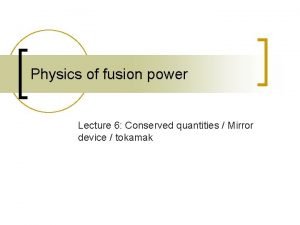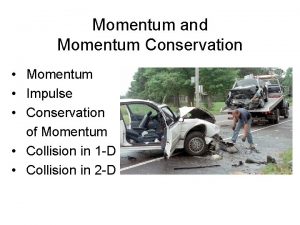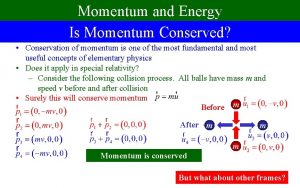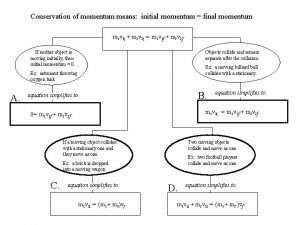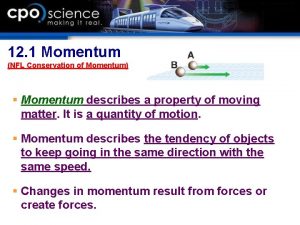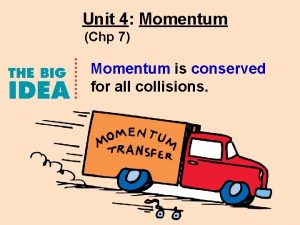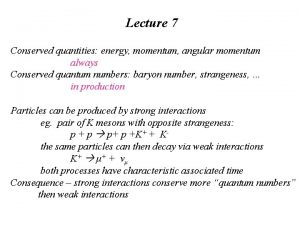Conservation of Momentum Momentum is Conserved So far












- Slides: 12

Conservation of Momentum

Momentum is Conserved �So far, we have only considered the momentum of one object at a time. �Now we will look at two (or more) objects interacting with each other. �Picture this. . . �You are playing pool. You strike the cue ball which hits the 8 ball. The 8 ball had no momentum before the collision. �During the collision the cue ball loses momentum and the 8 ball gains momentum. �The momentum the cue ball loses is the same amount that the 8 ball gained.

Momentum is Conserved �The Law of Conservation of Momentum: The total momentum of all objects interacting with one another remains constant regardless of the nature of the forces between the objects. m 1 v 1 + m 2 v 2 = m 1 v’ 1 + m 2 v’ 2 total initial momentum = total final momentum

Example �A 76 kg boater, initially at rest in a stationary 45 kg boat, steps out of the boat and onto the dock. If the boater moves out of the boat with a velocity of 2. 5 m/s to the right, what is the final velocity of the boat?

Solution �Given: m 1 = 76 kg m 2 = 45 kg v 1 = 0 v 2 = 0 v’ 1 = 2. 5 m/s to the right Unknown: m 1 v 1 + m 2 v’ 2 = ? = m 1 v’ 1 + m 2 v’ 2 (76)(0) + (45)(0) = (76)(2. 5) + (45)(v’ 2) 0 = (190) + (45)(v’ 2) 190 = (45)(v’ 2) 190/45 = v’ 2 = 4. 22 m/s

Types of Collisions

Elastic Collisions �A collision in which the total momentum and the total kinetic energy are conserved is called an elastic collision. �Elastic means that after a collision the objects remain separated. �Two objects collide and return to their original shapes with no loss of total kinetic energy. After the collision the two objects move separately. �Both the total momentum and total kinetic energy are conserved.

Example �A 0. 015 kg marble moving to the right at 0. 225 m/s makes an elastic head-on collision with a 0. 030 kg shooter marble moving to the left at 0. 180 m/s. After the collision, the smaller marble moves to the left at 0. 315 m/s. Assume that neither marble rotates before or after the collision and that both marbles are moving on a frictionless surface. What is the velocity of the 0. 030 kg marble after the collision?

Solution Given: m 1 = 0. 015 kg m 2 = 0. 030 kg v 1 = 0. 225 m/s to the right, v 1 = +0. 225 m/s v 2 = 0. 180 m/s to the left, v 2 = – 0. 180 m/s v’ 1 = 0. 315 m/s to the left, v’ 1 = – 0. 315 m/s Unknown: v’ 2 = ? m 1 v 1 + m 2 v 2 = m 1 v’ 1 + m 2 v’ 2 (. 015)(. 225) + (. 030)(-. 180) = (. 015)(-. 315) + (. 030)(v’ 2) (. 0034) + (-. 0054) = (-. 0047) + (. 030)(v’ 2). 0027 = (. 030)(v’ 2). 0027/. 030 = v’ 2. 09 = v’ 2

Collisions �Perfectly inelastic collision � A collision in which two objects stick together after colliding and move together as one mass is called a perfectly inelastic collision. � Example: The collision between two football players during a tackle. �Conservation of momentum for a perfectly inelastic collision: m 1 v 1 + m 2 v 2 = (m 1 + m 2)v’ total initial momentum = total final momentum

Example �A 1850 kg luxury sedan stopped at a traffic light is struck from behind by a compact car with a mass of 975 kg. The two cars become entangled as a result of the collision. If the compact car was moving with a velocity of 22. 0 m/s to the north before the collision, what is the velocity of the entangled mass after the collision? Given: m 1 = 1850 kg m 2 = 975 kg v 1 = 0 m/s v 2 = 22. 0 m/s north Unknown: v’

Solution �Choose your equation: m 1 v 1 + m 2 v 2 = (m 1 + m 2)v’ v’= m 1 v 1 + m 2 v 2 ( m 1 + m 2) v’ = (1850 kg)(0 m/s) + (975 kg)(22. 0 m/s) (1850 kg + 975 kg) v’ = 7. 59 m/s north
 Conservation momentum
Conservation momentum Momentum
Momentum Momentum is conserved
Momentum is conserved Is momentum conserved in all collisions
Is momentum conserved in all collisions Is angular momentum conserved in an inelastic collision
Is angular momentum conserved in an inelastic collision Conservation of linear momentum
Conservation of linear momentum Far far away city
Far far away city Paper seeming boy figure of speech
Paper seeming boy figure of speech This map becomes their window
This map becomes their window In a kingdom far far away
In a kingdom far far away Outward power coils
Outward power coils Example of mechanical energy
Example of mechanical energy Formula of potential and kinetic energy
Formula of potential and kinetic energy

